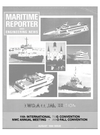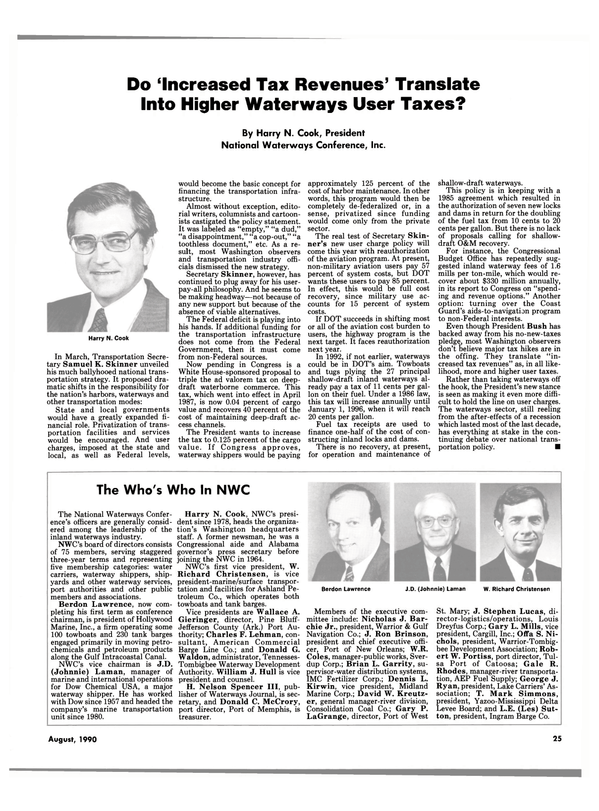
Do increased Tax Revenues' Translate Into Higher Waterways User Taxes?
In March, Transportation Secretary Samuel K. Skinner unveiled his much ballyhooed national transportation strategy. It proposed dramatic shifts in the responsibility for the nation's harbors, waterways and other transportation modes: State and local governments would have a greatly expanded financial role. Privatization of transportation facilities and services would be encouraged. And user charges, imposed at the state and local, as well as Federal levels, would become the basic concept for financing the transportation infrastructure.
Almost without exception, editorial writers, columnists and cartoonists castigated the policy statement.
It was labeled as "empty," "a dud," "a disappointment," "a cop-out," "a toothless document," etc. As a result, most Washington observers and transportation industry officials dismissed the new strategy.
Secretary Skinner, however, has continued to plug away for his userpay- all philosophy. And he seems to be making headway—not because of any new support but because of the absence of viable alternatives.
The Federal deficit is playing into his hands. If additional funding for the transportation infrastructure does not come from the Federal Government, then it must come from non-Federal sources.
Now pending in Congress is a White House-sponsored proposal to triple the ad valorem tax on deepdraft waterborne commerce. This tax, which went into effect in April 1987, is now 0.04 percent of cargo value and recovers 40 percent of the cost of maintaining deep-draft access channels.
The President wants to increase the tax to 0.125 percent of the cargo value. If Congress approves, waterway shippers would be paying approximately 125 percent of the cost of harbor maintenance. In other words, this program would then be completely de-federalized or, in a sense, privatized since funding would come only from the private sector.
The real test of Secretary Skinner's new user charge policy will come this year with reauthorization of the aviation program. At present, non-military aviation users pay 57 percent of system costs, but DOT wants these users to pay 85 percent.
In effect, this would be full cost recovery, since military use accounts for 15 percent of system costs.
If DOT succeeds in shifting most or all of the aviation cost burden to users, the highway program is the next target. It faces reauthorization next year.
In 1992, if not earlier, waterways could be in DOT's aim. Towboats and tugs plying the 27 principal shallow-draft inland waterways already pay a tax of 11 cents per gallon on their fuel. Under a 1986 law, this tax will increase annually until January 1, 1996, when it will reach 20 cents per gallon.
Fuel tax receipts are used to finance one-half of the cost of constructing inland locks and dams.
There is no recovery, at present, for operation and maintenance of shallow-draft waterways.
This policy is in keeping with a 1985 agreement which resulted in the authorization of seven new locks and dams in return for the doubling of the fuel tax from 10 cents to 20 cents per gallon. But there is no lack of proposals calling for shallowdraft O&M recovery.
For instance, the Congressional Budget Office has repeatedly suggested inland waterway fees of 1.6 mills per ton-mile, which would recover about $330 million annually, in its report to Congress on "spending and revenue options." Another option: turning over the Coast Guard's aids-to-navigation program to non-Federal interests.
Even though President Bush has backed away from his no-new-taxes pledge, most Washington observers don't believe major tax hikes are in the offing. They translate "increased tax revenues" as, in all likelihood, more and higher user taxes.
Rather than taking waterways off the hook, the President's new stance is seen as making it even more difficult to hold the line on user charges.
The waterways sector, still reeling from the after-effects of a recession which lasted most of the last decade, has everything at stake in the continuing debate over national transportation policy.
Read Do increased Tax Revenues' Translate Into Higher Waterways User Taxes? in Pdf, Flash or Html5 edition of August 1990 Maritime Reporter
Other stories from August 1990 issue
Content
- Largest Aluminum Charter Yacht In North America Delivered By Aluminum Boats page: 8
- Trinity Marine Group Licensed To Build Westamarin Aluminum Catamarans In United States page: 8
- Directions In Design Awarded Casino Boat Interior Design Contract page: 9
- Art Anderson Associates Expands Professional Staff page: 9
- Furuno Introduces New Shipboard Communications System page: 10
- Tidewater Adds 11 Boats To Domestic Fleet page: 10
- 'Reborn' Meridian Emerges From $55-Million Reconstruction At Lloyd Werft-Bremerhaven page: 11
- Cummins-Powered Aluminum Boat Delivered By Argo Marine For Logging Operation page: 12
- Service Marine To Build Dinner/Excursion Boat For Chicago Firm page: 12
- ASNE Symposium 1990 Set For Biloxi, Miss., September 27-29 page: 13
- Comsat Develops New High-Speed Data Service —Literature Available page: 13
- MSI Combines Emergency Medical Training Program With Shiphandling Course page: 14
- New Platinum Series Watermakers Introduced By Matrix Desalination page: 15
- ETA-Pilot Fuel Saving System Now Marketed Worldwide By SSPA page: 16
- New Designs And Developments From Munson Manufacturing In Oil Spill Response Vessels page: 18
- SeaArk Marine To Supply 19 Oil Spill Recovery Boats To State Of Florida page: 20
- Campbell Chain Develops New Process To Extend Chain Life page: 20
- IMO Double CIG Pumps Offer Increased Flow Rates At Lower Installed Cost page: 22
- Chantiers De L'Atlantique To Build Two Passenger Ships For Kloster Cruise page: 23
- Bird-Johnson Awarded MCM Propeller Contract page: 23
- National Waterway Conference To Hold Annual Meeting In New Orleans page: 24
- Do increased Tax Revenues' Translate Into Higher Waterways User Taxes? page: 25
- The Who's Who In NWC page: 25
- NWC: Promoting Sound & Far-Sighted Waterways Policies page: 26
- New Firefighting Foam Offered By Ansul For Flammable Liquid Fires page: 27
- Freeport Shipbuilding Begins Construction On Trend-Setting Carambat Megayacht/Houseboat page: 28
- Call For Papers Issued For 'Marine Computers '91' Symposium In Boston page: 29
- 11th International Tug Convention And International Marine Salvage Symposium page: 30
- ASSESSMENT OF THE U.S. MARINE MARKET page: 32
- Magellan Offers Low-Cost Portable GPS Receivers —Literature Available page: 33
- ASRY Dry Dock Occupancy Near 90 Percent During First Quarter page: 34
- Wartsila Diesel Announces Recent Personnel Appointments page: 34
- Coast Guard Announces Final Marine Vapor Control Regulations page: 35
- A New Course For AWO's Shipyard Conference page: 36
- Homeport Marine Delivers 'Eastern Wind/ First Of Two U.S.-Flag Fish Tenders page: 37
- NABRICO Delivers 260-Foot RO/RO Barges For Boston Harbor Project page: 37
- Furuno Introduces New FR/FAR-2800 Big Ship Radar/ARPA Line page: 40
- NuFlex Offers Composite Vapor Hoses For Transfer Operations page: 41
- Conferees A g r e e On Scheduling Of Tanker Double-Hull Phase-In page: 41
- New York Shipyard Reports Busy Vessel Repair Schedule page: 42
- $200-Million Japanese Liner Fitted With Magnavox Advanced Multi-Channel SatCom System page: 44
- Henschel Named Exclusive U.S. Licensee For Speed Measuring Units page: 45
- AMERICA'S SMALL- AND MEDIUM-SIZED YARDS REFERENCE GUIDE AND REVIEW page: 48
- Marine Gears Delivers Haley Units For Three Vessels At Main Iron page: 54
- COMSAT Acquires Interest In MMS page: 55
- ZF Announces Improvements In Four Marine Transmissions page: 56


